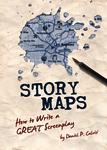Adapting a book to screenplay with Coppola Part I
The Godfather may be the most famous example of a great movie made from a poorly-written book. With the release of this page of text from Mario Puzo’s novel with hand-written notes by Francis Ford Coppola, we can see this claim in action! In other words, if you click on the image below and actually read the text, you can see how bad Puzo’s writing really was and breathe a sigh of relief that Coppola meticulously planned his translation to the screen.
As a guy who has read a lot of books on the job, I can tell you that the quality of the prose in a novel may get the book moved up the development ladder, but, ultimately, it doesn’t matter as much as the “bones” of the story, because a great screenwriter can theoretically mine greatness from a decent story that’s not yet fully realized in print. A screenplay is a much different animal than a novel, which is why it’s often difficult for novelists to get the hang of screenplay format (especially when adapting their own books, where they can find it extremely difficult to “drown their puppies”). I’ve worked with many talented novelists who brought me their first screenplays, and, like any other first-time screenwriter, it may have been a shock to see so many “Cut” and “Trim” notes, but my analysis turned out to be a great learning tool. We all over-write on our first drafts, but for the novelist who toiled over every word of their book (and I tip my hat to anyone who’s accomplished this massive task), it’s a crucial step in the development of their new craft to acknowledge what really doesn’t need to be put into the screenplay adaptation.
Mario Puzo, like Robert Ludlum (the Bourne movies) and Philip K. Dick (Blade Runner), happened to write some pretty mediocre books that have become excellent movies (to be fair, Puzo said that “The Godfather” was actually his least favorite of his books), because these authors are primarily great “conceptualists,” so their work can be handed off to talented screenwriters and filmmakers to adapt book to film.
I’m okay with that. I’m not here to beat up on famous authors. I just wanted to use this document as an opportunity to point out how crucial it is for a screenwriter to adapt a book and capture its essence without being a slave to its every word. If you’re adapting a book or other source material, you must be open to making changes to the source text to make the story more “active” and less internal.
Here’s some things you can do to make a novel work better on screen:
- Change phone conversations to face-to-face meetings in interesting locations, and give the characters some kind of “business” to do.
- Decide how much of your protagonist’s backstory is crucial and try to show it rather than only tell it in dialogue (Flashbacks, visual devices, character ticks, setups and payoffs, etc.).
- If you show a scene in the past, make sure it advances the plot in the present line of action.
- Only use voiceover narration if it’s crucial and will really enhance the audience experience. Your book may employ a fantastic first-person narrative voice, but that’s not an automatic reason to include voiceover in the screenplay.
- Try to stick to the Story Map in the source material, but be open to inserting your own “signpost” beats if that’s going to work best on screen and still capture the essence of the book.
- Pay attention to pacing as the book may not employ modern film pacing. (Notice how Coppola makes several notes about “time” in the document.)
Here’s the scene (graphic violence):
Tomorrow, in Part II, we’ll look deeper into the mechanics of this crucial scene from The Godfather.
Good Luck and Happy Writing,
Dan Calvisi
P.S. Our buddies at Screenplay How To also have some thoughts on Coppola’s Godfather notes: Link.





Trackbacks & Pingbacks
[…] Check out Act Four Screenplays for some great commentary on adapting The Godfather from novel to screenplay. […]
Leave a Reply
Want to join the discussion?Feel free to contribute!